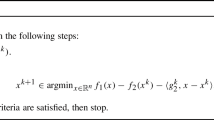Abstract
Inter-cell interference mitigation is a key challenge in the heterogeneous wireless networks which are expected to use an aggressive frequency reuse factor and a high-density access point deployment to improve coverage and spectral efficiency. In this paper, the problem of resources allocation in multicell Orthogonal Frequency Division Multiple Access wireless system is considered with universal frequency reuse and target of Weighted Sum-Rate Maximization. We address multi cell modified iterative water filling as an iterative power allocation algorithm. Also, a new extension of fixed point implementation of Successive Convex Approximation for Low complExity (SCALE) algorithm to multicellular system [referred to as Multi Cell Fixed point SCALE (MCF-SCALE)] is presented and it has been shown both of them resulted to the same convergence point. It is also demonstrated that using Lagrangian multiplier instead of noise variance in Standard Yates framework (as has been used in some previous papers) is not a suitable method for proving convergence and all the previous results based on this pattern need to be revised. Finally, a new framework is presented for proving the convergence of MCF-SCALE algorithm based on Jacobi iterative algorithm. Moreover, some previous convergence criteria are shown to be interpreted as a special case of this condition.






Similar content being viewed by others
References
Cisco Visual Networking Index: Global Mobile Data Traffic Forecast Update, 2011–2016. (Feb 2012). http://www.cisco.com/en/US/solutions/collateral/ns341/ns525/ns537/ns705/ns827/white_paper_c11-520862.html.
Sadr, S., Anpalagan, A., & Raahemifar, K. (2009). Radio resource allocations for the downlink of multiuser OFDM communication systems. IEEE Communications Surveys & Tuts, 11(3), 92–105.
Kiani, S. G., & Gesbert, D. (2008). Optimal and distributed scheduling for multicell capacity maximization. IEEE Transcations on Wireless Communications, 7(1), 288–297.
Ksairi, N., Bianchi, P., Ciblat, P., & Hachem, W. (2010). Resource allocation for downlink sectorized cellular OFDMA systems: Part I-Optimal allocation. IEEE Transactions on Signal Process, 58(2), 720–734.
Weeraddana, P. C., Codreanu, M., Latva-aho, M., & Ephremides, A. (2011). Weighted sum-rate maximization for a set of interfering links via branch and bound. IEEE Transcations on Signal Processing, 59(8), 3977–3996.
Chang, R. Y., Tao, Z., Zhang, J., & Kuo, C. C. J. (2009). Multicell OFDMA downlink resource allocation using a graphic framework. IEEE Transactions on Vehicular Technology, 58(7), 3494–3507.
Rahman, M., & Yanikomeroglu, H. (2010). Enhancing cell-edge performance: A downlink dynamic interference avoidance scheme with inter-cell coordination. IEEE Transcations on Wireless Communications, 9(4), 1414–1425.
Venturino, L., Prasad, N., & Wang, X. (2009). Coordinated scheduling and power allocation in downlink multicell OFDMA networks. IEEE Transactions on Vehicular Technology, 58(6), 2835–2848.
Son, K., Lee, S., Yi, Y., & Chong, S. (2011). REFIM: A practical interference management in heterogeneous wireless access networks. IEEE Journal of Selected Areas Communications, 29(6), 1260–1271.
Yu, W., & Lui, R. (2006). Dual methods for nonconvex spectrum optimization of multicarrier systems. IEEE Transcations on Communications, 54(7), 1310–1322.
Papandriopoulos, J., & Evans, J. S. (2009). SCALE: A low-complexity distributed protocol for spectrum balancing in multiuser DSL networks. IEEE Transcations on Information Theory, 55(8), 3711–3724.
Yates, R. D. (1995). A framework for uplink power control in cellular radio systems. IEEE Journal of Selected Areas Communications, 13(7), 1341–1347.
Yu, W. (2007). Multiuser water-filling in the presence of crosstalk. San Diego, CA: Proc. Information Theory Applications (ITA).
Cover, T. M., & Thomas, J. A. (2006). Elements of information theory. New York: Wiley.
Luo, Z. Q., & Zhang, S. (2008). Dynamic spectrum management: Complexity and duality. IEEE Journal of Selected Topics in Signal Processing, 2(1), 57–73.
Boyd, S., & Vandenberghe, L. (2004). Convex optimization. Cambridge, UK: Cambridge University Press.
Horst, R., Pardalos, P. M., & Thoai, N. V. (1995). Introduction to global optimization. Dordrecht: Kluwer.
Yu, W., Ginis, G., & Cioffi, J. M. (2002). Distributed multiuser power control for digital subscriber lines. IEEE Journal of Selected Areas Communications, 20(5), 1105–1115.
Lee, K., Jo, O., & Cho, D. H. (2011). Cooperative resource allocation for guaranteeing intercell fairness in femtocell networks. IEEE Communications Letters, 15(2), 214–216.
Wendland, H. (2010). mt201011 course notes on numerical linear algebra. Oxford University. http://people.maths.ox.ac.uk/wendland/teaching/mt201011/.
Scutari, G., Palomar, D. P., & Barbarossa, S. (2008). Optimal linear precoding strategies for wideband noncooperative systems based on game theory-part I: Nash equilibria. IEEE Transcations on Signal Processing, 56(3), 1230–1249.
Wang, F., Krunz, M., & Cui, S. (2008). Price-based spectrum management in cognitive radio networks. IEEE Journal of Selected Topics in Signal Processing, 2(1), 74–87.
Han, Z., Ji, Z., & Liu, K. J. R. (2007). Non-cooperative resource competition game by virtual referee in multi-cell OFDMA networks. IEEE Journal of Selected Areas Communications, 25(6), 1079–1090.
E-UTRA and E-UTRAN Overall description; Stage 2 (Release 8). (2008). 3GPP Technical Specification TS 36.300 V8.7.0. http://www.3gpp.org.
Bang, H. J., Gesbert, D., & Orten, P. (2012). On the rate gap between multi- and single-cell processing under opportunistic scheduling. IEEE Transcations on Signal Processing, 60(1), 415–425.
Acknowledgments
The authors would like to acknowledge the supports of Research Institute for ICT—ITRC and I. R. Iran Ministry of Science, Research and Technology.
Author information
Authors and Affiliations
Corresponding author
6 Appendix
6 Appendix
Proof of Theorem 4
The row sum norm is used to calculate the norm of the iteration matrix C:
Hence, we have convergence. \(\square \)
Proof of Proposition 4
For equation \(\mathbf{D}^{n}\mathbf{q}^{n}=\mathbf{\lambda } \ln 2\), if the iterative Jacobi algorithm (51) is written, the following can be obtained
However, since \(q_m^n \,{\mathop {=}\limits ^{\Delta }}\, \left({p_m^n}\right)^{-1}\), this relation has the same form as MCF-SCALE algorithm, as obtained in (29). \(\square \)
Rights and permissions
About this article
Cite this article
Akbari, M.H., Vakili, V.T. Convergence of Price-Based Resource Allocation Algorithms in Multicellular Multicarrier Systems. Wireless Pers Commun 71, 3069–3090 (2013). https://doi.org/10.1007/s11277-012-0991-x
Published:
Issue Date:
DOI: https://doi.org/10.1007/s11277-012-0991-x




